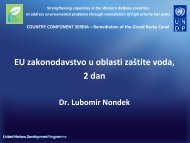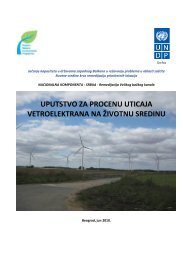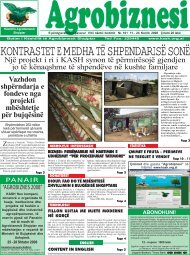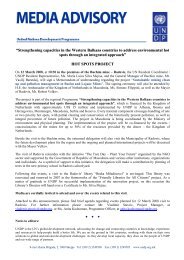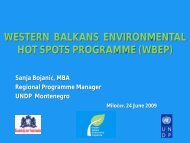Environmental monitoring in Tuzla and Ugljevik - Western Balkans ...
Environmental monitoring in Tuzla and Ugljevik - Western Balkans ...
Environmental monitoring in Tuzla and Ugljevik - Western Balkans ...
You also want an ePaper? Increase the reach of your titles
YUMPU automatically turns print PDFs into web optimized ePapers that Google loves.
HOT SPOT<br />
PROJECT BOSNIA AND HERZEGOVINA<br />
<strong>Environmental</strong> <strong>monitor<strong>in</strong>g</strong><br />
<strong>in</strong> <strong>Tuzla</strong> <strong>and</strong> <strong>Ugljevik</strong><br />
<strong>Environmental</strong> <strong>monitor<strong>in</strong>g</strong> <strong>and</strong> field surveillance<br />
tra<strong>in</strong><strong>in</strong>g<br />
Becici, Montenegro, 6-7.05.2009.
HS 2 - TUZLA<br />
HS 1 - UGLJEVIK
Project sites: sub-projects for Clean up<br />
1. <strong>Ugljevik</strong> M<strong>in</strong>e <strong>and</strong> Thermo-Power Plant:<br />
“Re-construction of facility for de-m<strong>in</strong>eralization/decarbonation<br />
processes”, (waste water discharges<br />
reduction);<br />
2. <strong>Tuzla</strong> Town<br />
“Reduction of air pollution by connect<strong>in</strong>g of University Cl<strong>in</strong>ic<br />
Centre to the central Heat<strong>in</strong>g system”.
<strong>Ugljevik</strong> Thermo Power Plant – Hot Spot
Problem <strong>in</strong> focus – <strong>Ugljevik</strong> site<br />
• Captur<strong>in</strong>g of huge amount of water from the river;<br />
• Import of certa<strong>in</strong> amount of chemicals from other countries;<br />
• Weak <strong>monitor<strong>in</strong>g</strong> of the process;<br />
• Discharge of 120 t of salts <strong>in</strong>to the river per year.
The follow<strong>in</strong>g waste material is discharged from the<br />
plant for chemical preparation of water:<br />
• Carbonate mud/slime (4%), max 54 m3/h , consist<strong>in</strong>g of<br />
CaCO3 <strong>and</strong> Fe(OH)3 ma<strong>in</strong>ly, deported periodically to the<br />
l<strong>and</strong>fill for carbonate mud built purposely by the Thermo<br />
Power Plant <strong>Ugljevik</strong><br />
• Waste water from de-m<strong>in</strong>eralization; 150 m3/regen. With<br />
a large content of salts (910 g/m3-CaCl2, 970 g/m3-<br />
NaCl, 797 g/m3-Na2SO4) through the plants for waste<br />
waters treatment, after neutralization to the pH-value 7-<br />
8.5 is dicharged <strong>in</strong>to the river Mezgraja (Table 2.5)
Year<br />
Number of<br />
regenerations<br />
The amount of<br />
waste waters<br />
(m 3 )<br />
The amount of<br />
salts<br />
discharged <strong>in</strong><br />
the river (t)<br />
2003 285 42.75 114,44<br />
2004 318 47.7 127,69<br />
2005 279 41.85 112,03<br />
2006 342 51.3 137,33<br />
2007 363 54.45 145,76
Water quality analysis<br />
The quality of water <strong>in</strong> the rivers Janja <strong>and</strong> Mezgraja<br />
measured <strong>in</strong> the period from 2003-2007 is given <strong>in</strong><br />
tables bellow. The quality of water was also<br />
monitored/measured just before the river Janja runs<br />
<strong>in</strong>to the Thermo Power Plant. This shows the quality<br />
of the river Janja without the effect of the waste<br />
waters discharged from the Thermo Power Plant, as<br />
well as the plant for de-carbonization <strong>and</strong> dem<strong>in</strong>eralization.<br />
It is raw water affected by effluents<br />
from waste waters that enter its body before the<br />
Thermo Power Plant.
Total hardness<br />
Component Unit Janja bridge Mezgraja<br />
Carbonate hardness<br />
Ca- hardness<br />
Mg- hardness<br />
Non- carbonate hardness<br />
Janja down from the<br />
waste<br />
0 dH 14.62 51.16 18.05<br />
0 dH 13.1 18.53 12.96<br />
0 dH 9.6 32.25 11.51<br />
0 dH 5.09 18.37 6.55<br />
0 dH 1.57 31.88 5.16<br />
p-alkal<strong>in</strong>ity mmol/l 0,00 0,00 0,00<br />
m-alkal<strong>in</strong>ity mmol/l 4.65 6.62 4.65<br />
pH-value - 8.02 7.98 8.09<br />
SiO2 mg/l 5.23 6.95 5.58<br />
Chlorides mg/l 7.83 11.98 14.57<br />
Sulphates mg/l 53.47 1068.62 176.53<br />
Iron (total) mg/l 0.052 0.13 0.084<br />
Sodium mg/l 18.2 149.94 37.43<br />
KMnO4 mg/l 13.64 22.43 15.8<br />
Suspended material mg/l 42.47 170.32 52.66<br />
Evaporation residue mg/l 287.16 1794.62 466.47<br />
Conductivity µS/cm 378.79 1919.14 600.28<br />
Temperature<br />
0 C 12.34 13.1 12.77<br />
HPK mg/l 29.92 43.59 29.65
Pollution sources impact<strong>in</strong>g Janja river<br />
Upstream of the Thermo Power Plant <strong>Ugljevik</strong> – the river<br />
Janja is expected to receive waste waters from two<br />
plants:<br />
• The slaughter house<br />
• the chicken farm<br />
• Other smaller emitters<br />
• This region of the river Janja does not have any sewage<br />
systems for the removal of municipal waste waters<br />
– Introduction of a physical pretreatment (to remove all<br />
solid materials, suspended materials, fats <strong>and</strong> oils)<br />
• The Thermo Power Plant <strong>Ugljevik</strong> controls the discharge<br />
of its own waste
• It is assumed that firms upstream of TPP <strong>Ugljevik</strong> collect<br />
waste waters without any treatment, <strong>and</strong> then discharge<br />
it <strong>in</strong>to the river Janja, usually by night.<br />
• Incident <strong>in</strong> 1998 - the process of de-carbonization <strong>and</strong><br />
de-m<strong>in</strong>eralization was obstructed <strong>in</strong> chemical<br />
preparation of water , s<strong>in</strong>ce the reactor was<br />
overwhelmed with enormous quantities of foam.<br />
• Water quality analysis of Janja river <strong>in</strong> 1998:<br />
– several samples of water from the river were taken<br />
<strong>and</strong> sent it for an analysis to the Faculty of<br />
Technology <strong>and</strong> Metallurgy <strong>in</strong> Belgrade.<br />
– The results, were <strong>in</strong>dicat<strong>in</strong>g that the quality of water<br />
<strong>in</strong> the river Janja had changed. Apart from this<br />
<strong>in</strong>cident, there have been several more endanger<strong>in</strong>g<br />
the quality of the river Janja.
• In order to provide natural quality of water of the river<br />
Janja, as raw water used by the Thermo Power Plant<br />
<strong>Ugljevik</strong> <strong>and</strong> treated <strong>in</strong> the plants for de-carbonization<br />
<strong>and</strong> de-m<strong>in</strong>eralization, it is necessary to:<br />
• provide a strict control of the discharge of waste waters<br />
<strong>and</strong> materials up the stream of the location where the<br />
water is taken<br />
• Install a suitable <strong>monitor<strong>in</strong>g</strong> system - solution for this<br />
problem <strong>and</strong> facilitate the operation process of the plant<br />
for water preparation.
Water quality analysis<br />
Water <strong>and</strong> waste water quality is monitored <strong>in</strong> the<br />
plant (certa<strong>in</strong> analyses only) <strong>and</strong> Central laboratory of<br />
the Thermo Power Plant <strong>Ugljevik</strong> . The laboratory is<br />
not certified by ISO 17025, <strong>and</strong> all the analyses are<br />
done acord<strong>in</strong>g to procedures accepted <strong>in</strong> all the<br />
thermo power plants <strong>in</strong> the regions of Former<br />
Yugoslavia. The laboratory keeps the <strong>in</strong>structions for<br />
every analysis. The reports from the analyses are<br />
written on special forms <strong>and</strong> are sent to head<br />
eng<strong>in</strong>eer of the laboratory, head eng<strong>in</strong>eer of VPV,<br />
process eng<strong>in</strong>eer <strong>and</strong> environment protection<br />
eng<strong>in</strong>eer.<br />
Next table review of the equipment <strong>and</strong> methods for<br />
analysis <strong>in</strong> the Central chemical laboratory of the<br />
Thermo Power Plant <strong>Ugljevik</strong>
Parameter Method Equipment<br />
pH-value electrochemical pH-meter<br />
conductivity electrochemical cundoctometer<br />
Sulfates, iron, phosphates, silicon,<br />
copper photometric<br />
Spectrophotometer,<br />
colorimeter<br />
Sodium Flame photometric Flame photometer<br />
Hardness, p <strong>and</strong> m-alkality,<br />
chlorides, chemical use up of<br />
oxygen, organic substances<br />
(KMnO4)<br />
Suspended materials, vaporization<br />
residue<br />
titrimetric<br />
gravimetric<br />
Laboratory glass<br />
vessels<br />
Scales, dryers, hot<br />
plates
Dur<strong>in</strong>g the period from 2004 – 2007 the TPP <strong>Ugljevik</strong> laboratory has<br />
measured follow<strong>in</strong>g parameters at the Janja <strong>and</strong> Mezgraja rivers:<br />
• Total hardness,<br />
• Carbonate hardness,<br />
• Ca- hardness,<br />
• Mg- hardness,<br />
• Non- carbonate hardness,<br />
• p-alkal<strong>in</strong>ity,<br />
• m-alkal<strong>in</strong>ity,<br />
• pH-value,<br />
• SiO2,<br />
• Chlorides, Sulphates, Phosphates,<br />
• Iron, Copper (Cu+2), Sodium,<br />
• KMnO4,<br />
• Suspended material,<br />
• Evaporation residue,<br />
• Conductivity,<br />
• Temperature,<br />
• HPK.
Results<br />
• Waste waters from the process of de-m<strong>in</strong>eralization<br />
which conta<strong>in</strong> calcium <strong>and</strong> sodium salts of 145.76 t/year<br />
(the year 2007) affect the quality of water <strong>in</strong> the rivers<br />
Mezgraja, Janja <strong>and</strong> Dr<strong>in</strong>a.<br />
• The average flow of water <strong>in</strong> the river Mezgraja of 0.309<br />
m/s - the value of contam<strong>in</strong>ation of the water system of<br />
14.9 g/m3, i.e.14.9 mg/l.
• Salts are not particularly toxic - effect on the water<br />
quality of the Janja can be tolerated<br />
• reduc<strong>in</strong>g the amount of salts as much as possible or<br />
even elim<strong>in</strong>ate completely the amount of the salts that<br />
are discharged <strong>in</strong>to the river rema<strong>in</strong>s the primary goal.<br />
• the emitted waste waters which conta<strong>in</strong> the listed salts <strong>in</strong><br />
average percentages of 14.9 mg/l <strong>in</strong> the river Mezgraja,<br />
are unfavourable for the aquatic life,<br />
• reconstruction of the plant for de-carbonization <strong>and</strong> dem<strong>in</strong>eralization<br />
with<strong>in</strong> chemical preparation of water <strong>in</strong> the<br />
Thermo Power Plant <strong>Ugljevik</strong>.
<strong>Environmental</strong> <strong>monitor<strong>in</strong>g</strong> plan<br />
In order to establish an efficient environmental <strong>monitor<strong>in</strong>g</strong><br />
system <strong>and</strong> for the analyses to be more complete it is<br />
necessary to :<br />
1. apply ISO 17025,<br />
2. to certify methods,<br />
3. renew some apparatures <strong>and</strong> purchase new ones, which<br />
could measure other parameters (e.g. heavy metals <strong>and</strong><br />
other):<br />
• automatic sampler ,<br />
• anion device for determ<strong>in</strong><strong>in</strong>g anions ,<br />
• atomic absorption spectrophotometer,<br />
• gas chromatograph,<br />
• apparatus for biological oxygen use-up,<br />
• oxymeter.
In order to have a full perception of the actual effect of<br />
the waste waters from the process of de-m<strong>in</strong>eralization<br />
<strong>in</strong> the Thermo Power Plant <strong>Ugljevik</strong> on the quality of<br />
water <strong>in</strong> the rivers Mezgraja, Janja <strong>and</strong> Dr<strong>in</strong>a, the<br />
follow<strong>in</strong>g programme should be implemented:<br />
• Monitor<strong>in</strong>g of the quality of water of the river Janja ,<br />
• Simultaneous <strong>monitor<strong>in</strong>g</strong> of the quality of water of the<br />
river Janja after the reception of waste waters from the<br />
Thermo Power Plant <strong>Ugljevik</strong>,<br />
• Monitor<strong>in</strong>g of the quality of water of the river Janja before<br />
it flows <strong>in</strong>to the Dr<strong>in</strong>a,<br />
• Monitor<strong>in</strong>g of the quality of water of the river Dr<strong>in</strong>e before<br />
the river Janja flows <strong>in</strong>to it, <strong>and</strong><br />
• Monitor<strong>in</strong>g of the quality of water of the river Dr<strong>in</strong>e after<br />
the river Janja flows <strong>in</strong>to it
<strong>Ugljevik</strong> Hotspot – Expected Results of the<br />
project<br />
• Improvement of technology;<br />
• Less water to be captured from the river;<br />
• Sav<strong>in</strong>gs to be made <strong>in</strong> further exploitation –<strong>and</strong><br />
sav<strong>in</strong>gs for economy (abt 40% less chemicals to be<br />
<strong>in</strong> use;<br />
• Automatic <strong>monitor<strong>in</strong>g</strong> on permanent basis to be<br />
applied<br />
• Concentration of salts <strong>in</strong> Waste water to be reduced<br />
for 40% (environmental effect)
Identified problems:<br />
<strong>Tuzla</strong> - Hot Spot<br />
• Power Plant located near the Hospital Build<strong>in</strong>g <strong>and</strong><br />
with<strong>in</strong> urban zone of <strong>Tuzla</strong>;<br />
• Only coal as energy source (CO2, SO2…, specific smell)<br />
• Direct impact on air pollution;<br />
• Monitor<strong>in</strong>g applied but only concern<strong>in</strong>g few polluters on<br />
ad hoc basis;<br />
• Transportation, storage of coal, ash disposal;<br />
• Efforts of Cl<strong>in</strong>ical Center to obta<strong>in</strong> <strong>in</strong>ternationally<br />
recognized certificates
<strong>Tuzla</strong> – Grad<strong>in</strong>a Hospital
<strong>Environmental</strong> <strong>monitor<strong>in</strong>g</strong> <strong>in</strong> <strong>Tuzla</strong><br />
Air quality measurements<br />
• Monitor<strong>in</strong>g of sulphur-dioxide <strong>and</strong> black smoke<br />
concentrations<br />
• Results of the <strong>monitor<strong>in</strong>g</strong>:<br />
• it demonstrates that average SO2 concentrations <strong>in</strong><br />
the period between 2002 <strong>and</strong> 2005 were somewhat<br />
lower than 1990-1991.<br />
• the average 2007 SO2 level was significantly higher<br />
• the average black smoke concentrations showed a<br />
steady <strong>in</strong>crease, with maximum values <strong>in</strong>dicat<strong>in</strong>g<br />
that the legal threshold (“high level”) may have been<br />
exceed more than 7 times per year.
• In the period by 2002, measurements were conducted<br />
occasionally us<strong>in</strong>g analytical absorption<strong>and</strong> gravimetric<br />
methods.<br />
• In March 2003, an automatic air quality <strong>monitor<strong>in</strong>g</strong> system<br />
has been established for the area of <strong>Tuzla</strong> Canton. 5 stationary<br />
<strong>and</strong> 1 mobile air quality <strong>monitor<strong>in</strong>g</strong> stations have s<strong>in</strong>ce been<br />
<strong>in</strong> use, each compris<strong>in</strong>g 5 analyzers:
– air temperature <strong>and</strong> humidity analyzer<br />
– global radiation analyzer<br />
– SO2 concentration API 100A analyzer (UV<br />
fluorescence method) , EPA9 approved<br />
– CO concentration API 300A analyzer (IR<br />
spectroscopic method), EPA approved<br />
– NOX concentration API 200A analyzer<br />
(chemilum<strong>in</strong>escence method), EPA approved<br />
– O3 concentration API 400 analyzer (UV photometric<br />
method), EPA approved<br />
– PM2.5 concentration TEOM 400a analyzer<br />
(gravimetric method <strong>in</strong> accordance with EN 12341)
Conclusion:<br />
Based on the air <strong>monitor<strong>in</strong>g</strong> done <strong>in</strong> previous years, it<br />
can be concluded that:<br />
i) <strong>Tuzla</strong> town average values of particulate matter<br />
concentrations exceeded the legal thresholds <strong>and</strong> were<br />
2-3 times higher than the values reported for comparable<br />
size European <strong>in</strong>dustrial towns; <strong>and</strong><br />
ii) <strong>Tuzla</strong> town peak values of all the three monitored<br />
pollutants heavily exceeded the legal thresholds for an<br />
unidentified number of times, <strong>and</strong> were several times<br />
higher than peak values <strong>in</strong> comparable size European<br />
<strong>in</strong>dustrial towns or other selected urban areas <strong>in</strong> the EU.<br />
Although not known to what degree, these particularly<br />
high values certa<strong>in</strong>ly may have been reflect<strong>in</strong>g on the<br />
general health of the <strong>Tuzla</strong> town population.
University Cl<strong>in</strong>ic Center - Grad<strong>in</strong>a<br />
The Grad<strong>in</strong>a Medical Centre (Grad<strong>in</strong>a Complex) is<br />
located at the eastern section of <strong>Tuzla</strong> town, on a slightly<br />
elevated hill between the Sol<strong>in</strong>a <strong>and</strong> Brcanska Malta<br />
neighborhoods.<br />
There are numerous block build<strong>in</strong>gs <strong>and</strong> <strong>in</strong>dividual<br />
residential houses <strong>in</strong> the surround<strong>in</strong>g of the Grad<strong>in</strong>a<br />
Complex. The closest watercourse is the Sol<strong>in</strong>a stream,<br />
a tributary of the Jala River, which is at a distance of<br />
some 100 m eastwards from the Complex. No<br />
<strong>in</strong>formation on the Sol<strong>in</strong>a stream water quality has been<br />
<strong>in</strong>dentified.
Air Emissions<br />
1-day measurements of pollutant emissions from<br />
Grad<strong>in</strong>a Complex heat<strong>in</strong>g system measured by Institute<br />
of Protection, Ecology <strong>and</strong> Education <strong>Tuzla</strong> <strong>in</strong> April 2008<br />
(ambient temperature was 14°C, i.e. <strong>in</strong> less<br />
representative conditions),<br />
– the concentrations of SO2 were approx. 12-23 times<br />
higher (approx. 650-1230 mg/m3),<br />
– concentrations of NOX approx. 3-4 times higher<br />
(approx. 51-93 mg/m3),<br />
– the PM concentrations were approx. 6-7 times lower<br />
(approx. 11-12 mg/m3) at somewhat higher exhaust<br />
gases flow (25,326 – 26,843 m3/h).
Assum<strong>in</strong>g that exhaust gases from each boiler dur<strong>in</strong>g the<br />
entire year on average conta<strong>in</strong> 15 mg/m3 NOX, 700<br />
mg/m3 SO2, 50 mg/m3 <strong>and</strong> PM total 40 mg/m3, at an<br />
average exhaust gases flow rate of 23,000 m3/h51, the<br />
average annual emissions from the heat<strong>in</strong>g system would<br />
be:<br />
Around 174 t/y SO2<br />
Around 12.5 t/y NOX<br />
Around 9.9 t/y PMtotal
Slag <strong>and</strong> ash<br />
• Grad<strong>in</strong>a Complex generates approximately 1,300 m3<br />
slag <strong>and</strong> ash per year.<br />
• Slag <strong>and</strong> part of ash are collected under the bottom<br />
grilles of boilers, while fly ash is caught <strong>in</strong> the exhaust<br />
cyclone<br />
• Reported coal consumption of 3,650 t/y, <strong>and</strong> the average<br />
content of <strong>in</strong>combustibles <strong>in</strong> the given coal of 26%55<br />
mass. - the annual quantity of slag <strong>and</strong> ash generated<br />
would be 1,651 t/y or 1,719 m3/y assum<strong>in</strong>g the specific<br />
gravity of slag/ash mix of 960 kg/m3<br />
• This figure may be somewhat higher depend<strong>in</strong>g on<br />
burn<strong>in</strong>g efficiency, due to the fact that the mass of slag<br />
can conta<strong>in</strong> particles of <strong>in</strong>completely burned coal<br />
dropp<strong>in</strong>g through the grilles<br />
• Assumption that between 1,300 <strong>and</strong> 1,500 m3 or 1,240 –<br />
1,440 tonnes of slag <strong>and</strong> ash are actually collected <strong>and</strong><br />
disposed of on an annual basis.
The collected slag <strong>and</strong> ashes are temporarily disposed<br />
of on a paved surface at the southern rim of the Grad<strong>in</strong>a<br />
Complex , <strong>and</strong> from there on transported by an external<br />
contractor for further end disposal or use <strong>in</strong> civil<br />
eng<strong>in</strong>eer<strong>in</strong>g activities. However, pollutants conta<strong>in</strong>ed <strong>in</strong><br />
the mass of slag <strong>and</strong> ashes can be occasionally<br />
transported to unprotected soil dur<strong>in</strong>g heavy<br />
precipitation.
Design of selected new heat<strong>in</strong>g systems<br />
• MC (Grad<strong>in</strong>a Complex) connection to district heat<strong>in</strong>g<br />
network<br />
• The connection pipel<strong>in</strong>e will have a length of 271 m <strong>in</strong><br />
total. Insulated, corrosion protected steel/Cr/Ni <strong>and</strong> hard<br />
polyethylene pipes will be <strong>in</strong>stalled <strong>in</strong> ditches<br />
• The metal pipes will be wrapped <strong>in</strong> protective<br />
polyethylene foil. Insulation materials will <strong>in</strong>clude<br />
polyurethane foam, bitumen <strong>and</strong> fabricated stone wool.<br />
• Prior to their placement on pipes, external pipe surfaces<br />
will be covered with an additional protective high<br />
temperature pa<strong>in</strong>t layer. Ready made heat transfer<br />
station, as well as pumps will also be <strong>in</strong>stalled.
Based on this, coal burn<strong>in</strong>g for heat<strong>in</strong>g needs will be<br />
elim<strong>in</strong>ated, however, the coal fired boilers will cont<strong>in</strong>ue to<br />
operate at a reduced capacity for the needs of<br />
sterilization steam <strong>and</strong> hot sanitary water production until<br />
further alternatives are <strong>in</strong>troduced. From environmental<br />
po<strong>in</strong>t of view, coal burn<strong>in</strong>g should ultimately be<br />
completely phased out.
Expected reduction of pollutant<br />
emissions <strong>and</strong> impacts through<br />
changes <strong>in</strong> heat<strong>in</strong>g system<br />
By connect<strong>in</strong>g the MC to district heat<strong>in</strong>g system, at least two<br />
thirds (67%) of the current coal consumption or 4,254.5 t/y<br />
will be phased out, whereas a maximum of 2,990.5 t/y coal<br />
would on average stay <strong>in</strong> use for the needs of steam <strong>and</strong> hot<br />
sanitary water provision until additional alternatives are<br />
<strong>in</strong>troduced for complete coal consumption phase out.<br />
Based on the latest heat dem<strong>and</strong> estimates <strong>and</strong> tak<strong>in</strong>g <strong>in</strong>to<br />
account the planned improved pipel<strong>in</strong>es <strong>in</strong>sulation, the<br />
rema<strong>in</strong><strong>in</strong>g coal consumption for steam <strong>and</strong> hot sanitary water<br />
will be even lower.
Therefore, after this <strong>in</strong>itial <strong>in</strong>vestment, equivalent<br />
reduction of at least 67% can also be expected <strong>in</strong> terms<br />
of air pollutants emission <strong>and</strong> slag generation, i.e.:<br />
- at least 114.8 t/y less SO2<br />
- at least 8.4 t/y less NOX<br />
- at least 6.6 t/y less PMtotal<br />
- at least 830.8 t/y less slag <strong>and</strong> ash (collected)
CONCLUSIONS AND RECOMMENDATIONS<br />
Expected overall project related reduction of<br />
environmental impacts<br />
Air quality <strong>in</strong> <strong>Tuzla</strong> area is severely affected by excessive<br />
air pollutant emissions. As a result of the <strong>in</strong>itial<br />
<strong>in</strong>vestment related to connection of MC to district heat<strong>in</strong>g<br />
system for the needs of MC heat<strong>in</strong>g, at least 67%<br />
reduction <strong>in</strong> coal consumption is expected to be<br />
achieved, with equivalent reduction <strong>in</strong> emissions of air<br />
pollutants <strong>and</strong> slag generation. The decrease <strong>in</strong> air<br />
emissions is expected to significantly contribute to<br />
improvement <strong>in</strong> air quality with<strong>in</strong> <strong>Tuzla</strong> town.
Recommendations for follow-up<br />
Follow<strong>in</strong>g the above described recommendations, it is<br />
necessary to <strong>in</strong>itiate activities to provide a framework for<br />
<strong>in</strong>creas<strong>in</strong>g energy efficiency with<strong>in</strong> the hospitals`<br />
operation. For this reason, EIS recommends specific<br />
activities that should be implemented <strong>in</strong> the <strong>in</strong>itial phase<br />
of system development. The recommendations refer to<br />
development of feasibility studies which are to determ<strong>in</strong>e<br />
the suitability of the technology <strong>in</strong> terms of its technical,<br />
economic <strong>and</strong> environmental performance. Three ma<strong>in</strong><br />
activities should be <strong>in</strong>itiated:<br />
• Conduct a feasibility study of implement<strong>in</strong>g energy<br />
efficiency measures<br />
• Conduct a feasibility study of <strong>in</strong>troduc<strong>in</strong>g renewable<br />
energy sources<br />
• Develop <strong>and</strong> adopt <strong>in</strong>ternal procedures on energy<br />
management
<strong>Environmental</strong> <strong>monitor<strong>in</strong>g</strong> concept<br />
For the given air pollution source addressed by the<br />
Project (Grad<strong>in</strong>a Complex heat<strong>in</strong>g system), consider<strong>in</strong>g<br />
the topography, likely prevail<strong>in</strong>g w<strong>in</strong>d directions, <strong>and</strong> the<br />
possible distribution patterns, the follow<strong>in</strong>g <strong>monitor<strong>in</strong>g</strong><br />
programme is recommended:<br />
Monitor<strong>in</strong>g po<strong>in</strong>ts<br />
Site Grad<strong>in</strong>a Complex<br />
8 po<strong>in</strong>ts: at 50 <strong>and</strong> 100 m to N, S, E <strong>and</strong><br />
W from Grad<strong>in</strong>a Complex<br />
Reference Values<br />
(μg/m3)59<br />
SO2 : 20<br />
Pollutants monitored SO2, NO2, PM2.5 <strong>and</strong> PM10 NO2 : 40<br />
Sampl<strong>in</strong>g period All pollutants: 24 h PM2.5: 25<br />
Frequency<br />
1x/ year: Basel<strong>in</strong>e measurements dur<strong>in</strong>g<br />
w<strong>in</strong>ter 2008/2009 + Follow<strong>in</strong>g 2<br />
years at identical <strong>monitor<strong>in</strong>g</strong> po<strong>in</strong>ts<br />
PM10: 40
• Hav<strong>in</strong>g <strong>in</strong> m<strong>in</strong>d that one mobile air quality <strong>monitor<strong>in</strong>g</strong><br />
station is already <strong>in</strong> use on the territory of <strong>Tuzla</strong>, it is<br />
recommended to approach the <strong>Tuzla</strong> Canton M<strong>in</strong>istry of<br />
Spatial Plann<strong>in</strong>g <strong>and</strong> <strong>Environmental</strong> Protection as the<br />
equipment owner <strong>and</strong> agree on arrangements for the<br />
proposed measurements. The M<strong>in</strong>istry staff <strong>in</strong> charge of<br />
operat<strong>in</strong>g <strong>and</strong> ma<strong>in</strong>ta<strong>in</strong><strong>in</strong>g the <strong>monitor<strong>in</strong>g</strong> stations (1<br />
eng<strong>in</strong>eer <strong>and</strong> 1 technician) should be contracted to<br />
conduct the <strong>monitor<strong>in</strong>g</strong> for the needs of MC. Hav<strong>in</strong>g <strong>in</strong><br />
m<strong>in</strong>d that the available particulate matter analyzer is<br />
currently used only for PM2.5 <strong>monitor<strong>in</strong>g</strong>, supplemental<br />
sampl<strong>in</strong>g head or filter allow<strong>in</strong>g for PM10 measurements<br />
should be procured.
<strong>Tuzla</strong> Hot Spot – expected results<br />
- Central heat<strong>in</strong>g system of the Town can satisfy needs of<br />
Cl<strong>in</strong>ical center dur<strong>in</strong>g heat<strong>in</strong>g season (Oct. – Apr.);<br />
- Efficient utilization of exist<strong>in</strong>g resources;<br />
- Reduction of air pollution as direct benefit to environment<br />
<strong>and</strong> people;<br />
- Elim<strong>in</strong>ation/significant reduction of problems caused <strong>in</strong><br />
process of transportation, ash disposal, storage;<br />
- Improvement of communal <strong>in</strong>frastructure<br />
- Contribution to overall picture of Cl<strong>in</strong>ical centre <strong>and</strong> Town<br />
(certification process)
Thank you!







